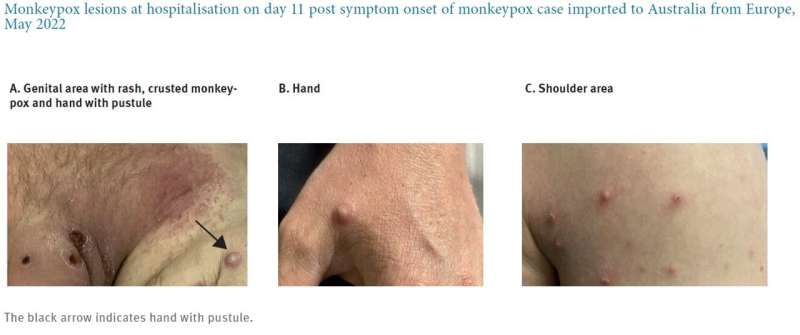
Monkeypox is a zoonotic disease, which means it can be transmitted between animals and humans via direct or indirect contacts. Following the eradication of smallpox and the end of universal smallpox vaccination, monkeypox is currently the most prevalent orthopoxvirus infection in humans.
Since May 2022, an evolving outbreak of monkeypox cases has been reported by several countries worldwide, mainly affecting young men self-identifying as men who have sex with men. Four rapid communications published in Eurosurveillance today describe cases diagnosed in Italy, Portugal, the United Kingdom (UK) and Australia.
UK: one outbreak, three separate incidents
Vivancos et al. describe the epidemiology and the public health response of a monkeypox outbreak in the UK, with 86 confirmed cases of monkeypox virus infections between 7 and 25 May 2022.
The authors grouped the currently known cases into three distinct incidents: an isolated laboratory-confirmed case following travel to Nigeria, two confirmed monkeypox cases from a separate household cluster including one case whose infections had already clinically resolved (no laboratory confirmation); and as the third incident, 82 laboratory-confirmed monkeypox cases that are neither linked to the two other incidents nor in which patients reported travel to areas where monkeypox is endemic.
While investigations are still ongoing to determine whether the cases in incident 3 might have been infected outside the UK, sexual health histories have identified links to sex on premises venues, private sex parties, and the use of geospatial dating apps, both in the UK and abroad. In the group linked to the third incident, information on gender was available for 79 cases, all of them men. Among these, a vast majority, 66 identified as gay or bisexual or other men who have sex with men.
So far, no single factor or exposure that links the cases has been identified.
According to Vivancos et al., “The current outbreak signals a change in basic assumptions about the epidemiology of MPXV in Europe with profound implications for surveillance and control,” and constitutes the first reported sustained transmission of MPXV in the UK with evidence of human-to-human transmission through close contact, including in sexual networks.
Possible previously undetected spread of monkeypox suspected in Portugal
Portugal confirmed the first ever case of human monkeypox in the country on 17 May 2022, and Duque et al. describe the outbreak detection of thus far 96 confirmed cases of monkeypox from the Lisbon and Tagus Valley region. Symptom onset for the first cases in Portugal was reported as early as 29 April 2022.
Most of the patients were not part of identified transmission chains, nor could a link to travel or contact with symptomatic persons or animals be established. According to the authors, this suggests possible previously undetected spread of monkeypox.
Among the 23 confirmed cases Duque et al. describe, 14 were HIV positive and the most common symptoms were exanthema (n = 14), inguinal lymphadenopathy (n = 14), fever (n = 13), genital ulcers (n = 6). The authors hypothesize “that MPX has been circulating below the detection of the surveillance systems. Although some cases have a clear epidemiological link, the lack of an identified exposure in others raises unanswered questions.”
Samples from seminal fluid in Italy positive for monkeypox
Vita et al. provide the clinical description of the four monkeypox cases reported in Italy, in adult men presenting with different clinical pictures from existing literature as the skin lesions were asynchronous, ranging from single or clustered spot to umbilicated papule with progressive central ulceration, and finally, to scabs. Lesions were mostly located in genital and perianal sites.
Biological samples from seminal fluid were positive for monkeypox viral DNA in all four patients, with a quantification cycle range from 27 to 30. Based on this, the authors hypothesize that “although these findings cannot be considered definitive evidence of infectivity, they demonstrate viral shedding whose efficiency in terms of transmission cannot be ruled out.”
Risk of bacterial superinfection
In their case description, Hammerschlag et al. share data on a virally suppressed HIV-positive patient who presented with a genital rash in Australia following a visit to Europe in May 2022, who was later hospitalized.
The clinical presentation in this case was considered atypical given the presence of rash exclusively on the site of sexual contact 3 days before developing fever and due to the preponderance for lesions in a central distribution with the least lesions present on the face and extremities after the rash disseminated.
Source: Read Full Article